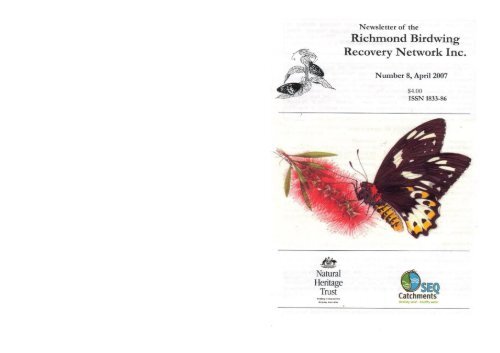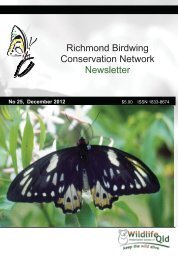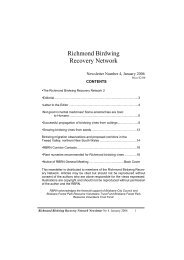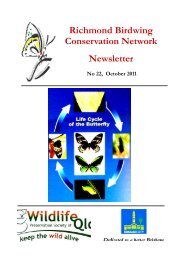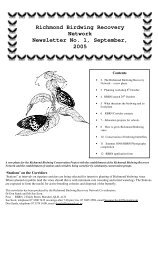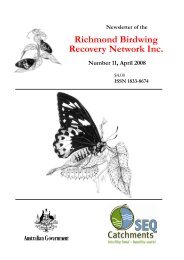Newsletter - Richmond Birdwing Conservation Network
Newsletter - Richmond Birdwing Conservation Network
Newsletter - Richmond Birdwing Conservation Network
Create successful ePaper yourself
Turn your PDF publications into a flip-book with our unique Google optimized e-Paper software.
Our cover illustration of a female <strong>Richmond</strong> birdwing feeding on bottlebrushnectar is from an original painting by Lois Hughes. Prints beautifully reproducedon quality watercolour paper (295 x 210 cm) are available from LoisHughes (ph. (07) 3206 6229) for $20 per print + postage.The RICHMOND BIRDWING RECOVERY NETWORK INC. since it waslaunched in 2005, has promoted conservation of the <strong>Richmond</strong> birdwingbutterfly Ornithoptera richmondia, its habitats and food plants. Membershipof the <strong>Network</strong> is open to anyone interested in conserving the <strong>Richmond</strong>birdwing and other insects of conservation concern. The <strong>Network</strong> promotesliaison between interested community members, catchment groups andrelevant local and state government authorities. The <strong>Network</strong> holds quarterlyGeneral Meetings, occasional Regional or Special Meetings and publishesquarterly, a <strong>Newsletter</strong> distributed to the members.OFFICE BEARERS 2006-2006-07PresidentSecretaryDon Sands,Dawn Muirc/- RBRN, PO Box 855, c/- RBRN, PO Box 855,Kenmore, Qld 4069 Kenmore, Qld 4069dsands@big pond. net.audawnmuir@optusnet.com.auVice PresidentTreasurerGreg SiepenAlan Scottc/- RBRN, PO Box 855, c/- RBRN, PO Box 855,Kenmore, Qld 4069 Kenmore, Qld 4069Greg.siepen@brisbane.qld.gov.auCouncillorsChris HoskingJan Crosslandc/- RBRN, PO Box 855, c/- RBRN, PO Box 855,Kenmore, Qld 4069 Kenmore, Qld 4069cjmhosk@optus.com.aujancross@gil.com.auHugh Krenskec/- RBRN, PO Box 855,Kenmore, Qld 4069hkrenske@telisystems.com.auNOTICE OF ANNUAL GENERAL MEETINGThe next General Meeting of the <strong>Richmond</strong> <strong>Birdwing</strong> Recovery<strong>Network</strong> will be held from 12.45 - 3.30 pm on:FRIDAY 20TH JULY 2007IN THE LECTURE THEATRE AT CSIROQUEENSLAND CENTRE FOR ADVANCED TECHNOLOGIES2,643 MOGGILL ROAD, PINJARRA HILLSThe main business will be an address (from 1 - 2 pm)byProfessor Tim Newtitled -Recovery plans for insects: needs, designand implementationVISITORS ARE WELCOMERBRN acknowledges the financial and in-kind support of BrisbaneCity Council, Maroochy Council, Caloundra Council, South EastQueensland Catchments and several anonymous donors.This newsletter is distributed to members of the <strong>Richmond</strong> Birding Recovery<strong>Network</strong> Inc. Articles and illustrations should not be reproduced without permissionand acknowledgement of the authors and the <strong>Richmond</strong> <strong>Birdwing</strong>Recovery <strong>Network</strong> (RBRN). Statements made in the <strong>Newsletter</strong> do not necessarilyrepresent the views of the RBRN.<strong>Richmond</strong> <strong>Birdwing</strong> Recovery <strong>Network</strong> <strong>Newsletter</strong> No 8, April 2007 2<strong>Richmond</strong> <strong>Birdwing</strong> Recovery <strong>Network</strong> <strong>Newsletter</strong> No 8, April 2007 29
Ray Seddon (Lower Sunshine Coast) Dale Borgelt (Brisbane W. Subs.)theseddons@westnet.com.au daleborgelt@bigpond.com(07) 5494 0383 (07) 3374 1035Janette Wallis (Mid Sunshine Coast) John Moss (Eprapah Creek)mtcoolum@bigpond.com (07) 3245 2997(07) 54716794Sally Jenyns (Buhot Creek) Russell Mayo (Nth. Sunshine Coast)Sally.Jenyns@bigpond.com rsp.mayo@bigpond.com(07) 3219 0418 (07) 5485 0770Vanessa Bugg (North Sunshine Coast) Veronica Newbury (Main Divide)admin@australianbutterflies.com.au(07) 5485 5109 (07) 4688 6572Dr lan Gynther (Kin Kin Creek)busheare@toowoomba.qld.gov.auEva Ford (Mary River Catchment)lan.gynther@epa.qld.gov.au mreeceva@q4wide.net.au .03t v ~,rL~(07) 3202 0250 (07) 5482 4766Dick Bull (Cubberla / Witton Creek)Keith McCosh (Beaudesert Shire)richardbull@uqconnect.com keith mccosh@hotmail.com(07) 3378 0340 (07) 3288 4709* Corridor Coordinators represent the RBRN at local birdwing eventsand act as contacts for the community and local government representativesin their area. They may be elected at any time of the year and willbe asked to provide a report each year for activities in their areas, establishingvines to address habitat fragmentation of corridors, as well asplanting vines at Stations (public land) and Links (private properties).They also assist with documenting and mapping natural stands of vinesfor the RBRN National Data base.CONTENTSPAGEPRESIDENT'S REPORT ......................................................................... 4LETTERSMARY CAIRNCROSS SCENIC RESERVE LAUNCHES ITSBIRDWING BUTTERFLY GARDEN Mark Bonner ................................... 5BIRDWING BUTTERFLIES AT MOOLOOLAH Hilton Selvey ................ 5MAROOCHY COUNCIL'S RICHMOND BIRDWING BUTTERFLYWORKSHOP AT EUMUNDI Stephanie Reif and Amanda Ozolins....... 7REPORTS and ARTICLESPROGRESS AT BEERWAH AND THE CORRIDORS INCALOUNDRASHIRE Ray Seddon ......................................................... 9RECOVERY PLANS FOR THE BEAUDESERT SHIREKeith McCosh.................................................................................. 11A LAND FOR WILDLIFE PROFILE: PROVIDING A RICHMOND BIRD-WING FEEDING STATION NEAR KONDALILLAStephanie Reif (communicated by Amanda Ozolins) .................... 12NOTES FROM TALKS PRESENTED AT MAROOCHY COUNCIL'SRICHMOND BIRDWING WORKSHOP John Jeffreys17TISSUE CULTURE OF PARARISTOLOCHIA PRAEVENOSAPeter Bakker 18THE RICHMOND BIRDWING BUTTERFLY AT EUMUNDIHelen Hepburn 19RBRN MAPPING: THE DATABASE UPDATE Hugh Krenske ...... 21MINUTES OF THE FEBRUARY 2007 GENERAL MEETING 4CORRIDOR COORDINATORS 27<strong>Richmond</strong> <strong>Birdwing</strong> Recovery <strong>Network</strong> <strong>Newsletter</strong> No 8, April 2007 28<strong>Richmond</strong> <strong>Birdwing</strong> Recovery <strong>Network</strong> <strong>Newsletter</strong> No 8, April 2007 3
PRESIDENT'S REPORTDon SandsLooking back at the recent "butterfly season" the achievements by ourRBRN Members and community participants have far outweighed thefew disappointments the latter mostly attributable to the prolongeddrought. One disappointment has occurred on the Sunshine Coastwhere we have confirmed retreat of an old established breeding populationfrom the Kin Kin Creek area and another from the easterncoastal strip near Coolum Beach. In most localities declines in densitiesof the "old growth" birdwing vines and the associated impacts ofdrought on the quality of vines have put serious pressures on localbirdwing populations. However, we have seen the results of positiveefforts made by Members and Community Groups towards as theyplant more vines. There is firm evidence that this approach is a successfulRecovery Action as we see birdwings re-establishing whereverthe planted vines are sufficiently abundant to the north and southof Brisbane.On the Gold Coast there is very good news with recent sightings ofadults and eggs have been laid on vines at Burleigh Heads and MountTambourine, both being localities where birdwings had disappeared formany years. I have no doubt that planted vines are contributing to recolonisationand early recovery of birdwings wherever local drought hasnot been too severe. There is not such good news from the centre ofthe birdwing's range nearer Brisbane where all native fauna and flora(and the residents of Brisbane!) are suffering from the worst droughtsince European settlement.Thanks are due to our RBRN Corridor Coordinators for helping localcommunity members, providing assistance with Workshops and mappingof vines, and for encouraging community awareness and enthusiasm.<strong>Birdwing</strong> workshops on the Sunshine Coast in November at MaryCairncross Scenic Reserve, and February at Eumundi, proved to bevery successful. Plans are underway for birdwing Workshops at Noosaand Beaudesert ShireRecommended Nurseries for quality* birdwing Vines:Gary Einam, Proplant Nursery, Christine Hosking80 Robbs Road, 351 Boscombe RoadMorayfield, Qld 4506. Brookfield, Qld 4069einam@microed.com.au cjmhosk@optus.com.au(07) 5498 5592 (07) 3374 3453Ray Seddon Richard BullPO Box 317, PO Box 49,Beerwah QLD 4519. Indooroopilly, Qid 4068.,thef"seddons@westnet.com.au Richard.bull@uqconnect.net(07) 5494 0383BIRDWING VINES NOWAVAILABLE!Chris Hosking now has quality vines of Pararistolochia praevenosawith runners "Up the Stak& and ready to plant($6 each)Phone or ernail with your orders:cjmhosk@optus.com.au(07) 3374 3453Eds Note. Vines 'up the stake' are advanced enough to plant out.Experience showsthat seedlings orcutting grown plantsless than 12months old withoutclimbing runners, areextremely prone todrought andstrong light and are not likely to survive.Sincere thanks on behalf of RBRN to the speakers, demonstrators andlocal Councils, and those who helped with the organization of the previousWorkshops. All participants set very high standards for RBRN tocontinue at future events.<strong>Richmond</strong> <strong>Birdwing</strong> Recovery <strong>Network</strong> <strong>Newsletter</strong> No 8, April 2007 4<strong>Richmond</strong> <strong>Birdwing</strong> Recovery <strong>Network</strong> <strong>Newsletter</strong> No 8, April 2007 27
Protection Agency since both the butterfly and the vine are protected species andrequire their approvals.<strong>Newsletter</strong> Don Sands reported on plans to continue the new cover design thecurrent series will have a painting of the <strong>Birdwing</strong> Butterfly thanks to the generosityof the artist, Lois Hughes. The next issue is planned for April/May 2007. The Presidentwill send a letter of thanks to Lois Hughes for allowing her wonderful illustrationsto be used as our RBRN <strong>Newsletter</strong> fronispiece.Role of Corridor Coordinators Ray Seddon described what is involved in being aCorridor Coordinator and mentioned the numbers of people growing vines for the<strong>Network</strong>. Discussions included the stages suitable for planting, pot size, age sincegermination. Don Sands commented that there has been an apparent reduction inthe abundance of midges that fertilise the vine's flowers, resulting in reduced seedset.Tissue Culture The President reported that one of our members, Peter Bakker, hasmade progress with tissue culture of Pararistolochia praevenosa which will allowlarge scale cultivation of material from specific areas when seeds are in short supply.The President suggested an honours student will be sought to investigate DNAand morphological variation in the vines from different localities and to comparewithin population variation (phenotypic plasticity).Mapping of birdwing vine distribution. Hugh Krenske described the data baseset up for the mapping of all historic data, planted areas, plant density, healthand size of vines, both current and historic lists. The web site will allow accessto the data base. Currently, there are three major areas: north eastern N S Wand Queensland: north of Brisbane and south of Brisbane. These areas will befurther separated into actual corridors or as municipal regions as they are established.Invited Speaker: The President, Don Sands introduced and welcomed theGuest Speaker, Dr Samantha Lloyd and congratulated her on gaining her Phl).Dr Lloyd spoke on the topic The Birds and the Bees: Pollination Ecology Essentials.A vote of thanks was moved by Dr lan Gynther after a most interesting presentationenjoyed by all. The pollination role of the midge in Pararistolochia praevenosa wasdiscussed.Next Annual General Meeting: The date, location, time and the Invited Speaker willbe announced in the next <strong>Newsletter</strong>.Close of Meeting. There being no further general business the President thankedmembers and visitors for attending and the Officer in Charge, CSIRO for allowing use oftheir meeting room. The President closed the Meeting at 4.15 pm.LETTERSMARY CAIRNCROSS SCENIC RESERVE LAUNCHES ITSBIRDWING BUTTERFLY GARDENMark BonnerI hardly know where to start with notes to record such an exciting FieldWorkshop and the informative field trip on Wednesday 14 th March2007, at Maleny. At this Workshop Mary Cairncross Scenic Reserve(MCSR) launched its future plans for a <strong>Richmond</strong> birdwing ButterflyGarden. Our <strong>Richmond</strong> birdwing Recovery <strong>Network</strong> Corridor Coordinatorand 'local' Ray Seddon, kindly opened up his property at Lower MtMellum for a visit by our group of volunteers, and gave us two hours ofinspirational information on the threatened <strong>Richmond</strong> birdwing Butterfly.Ray, accompanied by Dr. Don Sands, President of the RBRN andEntomologist. Don is recognised as the leading authority on the studyand recovery of this beautiful butterfly. Don is also working on theSouthern Pink Underwing Moth (Phyllodes imperialis ssp.) and he enthralledus with the wonders of the <strong>Richmond</strong> birdwing and the vine itdepends on Pararistolochia praevenosa. Both the birdwing and thisbeautiful moth are "at home" breeding in the Mary Cairncross ScenicReserve (MCSR).Don explained the life cycle and population dispersal of the butterflyand vine, the butterfly's disappearance from former strongholds suchas Kin Kin Creek, and the relevance of genetic identities of plants whenselecting vines for a particular area. Did you know that the birdwingbutterfly formerly ranged from Maryborough to Grafton and even possiblyas far as Coffs Harbour (one was once seen there!), or that the pupaecan delay development and hatching by going into diapause untilthe climatic conditions are appropriate? Jill Chamberlain then relayedher group's experiences with planting a butterfly garden at StanleyRiver Park at Peachester and monitoring vines for more than 10 years.Ray Seddon related his experiences of propagating vines and otherproperties, and the 'trial and error' way in which he has perfected growingand planting the vines. His property is now a haven for butterflieswith hundreds of vines planted to lure females into laying their eggs onthe leaves.Ray also unveiled drawings of a trellis which, when constructed, willallow vines to be planted and viewed from ground level at the teachingplatform in Mary Cairncross. The focus of the day, aside from the bird-<strong>Richmond</strong> <strong>Birdwing</strong> Recovery <strong>Network</strong> <strong>Newsletter</strong> No 8, April 2007 26<strong>Richmond</strong> <strong>Birdwing</strong> Recovery <strong>Network</strong> <strong>Newsletter</strong> No 8, April 2007 5
central point for corridors of habitat to radiate out from. The sitechosen in Mary Cairncross Scenic Reserve is ideally placed toshare the message of this beautiful butterfly and vine with thepublic. Ray then lead our group on a tour of his beautiful property,showing us a mature vine in fruit and flower, caterpillars and pupatingcaterpillars, and his Taj Mahal chook shed which supportedmany vines. Then we travelled on to the nursery whereRay explained his successful tips for growing the vines. The dayfinished with plans to involve willing staff in constructing our vinetrellis for a mass planting in Spring, and an Education NoticeBoard along with an RBRN corridor map showing existing sitesand the establishment of new Stations and Links. This map willbe updated continually to show natural vine sites, planted Linksand Stations and most importantly, the corridors. Just as Ray andDon wrapped up their talks, as if on queue, a male and femalebutterfly fluttered past and hovered around a nearby tree forphoto opportunities what a fantastic sight!The <strong>Birdwing</strong> Butterfly Garden at Mary Cairncross Scenic Reservepromises to bring an exciting new education theme to theReserve while playing a vital role in saving an amazing species.This Project is guided by the members of RIBIRN and supportedby Caloundra City Council, Land for Wildlife, SE QueenslandCatchments Board, National Heritage Trust and Landcare groupsthroughout the Shire. Thanks to Ray and his wife Pam for allowingus this wonderful opportunity and to Don for his insights.<strong>Birdwing</strong> butterflies at MooloolahHilton SelveyThe <strong>Richmond</strong> birdwing is established in my area and last yearthe first eggs were laid on the 9th. September 2006 with five depositedon one vine. Since then there have been other eggs depositedon my vines, probably more than I have been able to find.In all, I have about 125 vines growing on my property and on theadjacent Council property. The first egg laid by a birdwing on myplanted vines occurred about 5 years ago.<strong>Richmond</strong> <strong>Birdwing</strong> Recovery <strong>Network</strong> <strong>Newsletter</strong> No 8, April 2007 6MINUTES OF THE GENERAL MEETING OF THE RICHMOND BIRDWINGRECOVERY NETWORK INC., HELD AT CSIRO, LONG POCKET ON FRI-DAY 23 RD FEBRUARY 2007Opening of Meeting: The President, Dr Don Sands, opened the meeting at 2 pm andwelcomed members and visitors. Don asked those present to sign the attendancesheetApologies: Received from Helen and Mal Hepbum, S. Jones, Dr Bryan Hacker, JuttaGodwin, Lois Hughes, Dick Bull, Anne Stone.Election of New Members. The President announced the new members already nominatedand seconded and they were elected by a show of hands.Minutes of the June General Meeting: The Minutes of the last General Meeting heldon 24 th June 2006 at'The Hut', Fleming Road Chapel Hill, were circulated in last<strong>Newsletter</strong>. Moved minutes be accepted: Graham Forbes, seconded: Greg Siepen;motion carried.Business arising from Minutes of the last General Meeting:(i) Greg Siepen has begun working with a new teacher at Brookfield School on theirRBRN student project.(ii) The President was asked to write an official letter of thanks to Sue Scott who hasresigned as Education Co ordinator. Greg Siepen has accepted that position.Financial Report The Treasurer, Alan Scott, presented the financial report. He remarkedthat there is a shortfall between the ledger figures and the bank statements of$191.50. Moved the Financial Report be received: Alan Scott, seconded Greg Siepen.General Business Workshops: Dawn Muir commented on the successful <strong>Richmond</strong><strong>Birdwing</strong> and Vine Workshop conducted by the Maroochy Shire Council at Eumundi, onSunday 18 th February 2007. A report on this Workshop will be published in a futureRBRN <strong>Newsletter</strong>Education: The Secretary, Dawn Muir reported on progress to date with collating members'ideas for RBRN educational publications and presentations. Members are encouragedto email Dawn with ideas and requests for educational material.Captive Breeding Program. The Vice President, Greg Siepen spoke about the proposedCaptive Breeding Program for the birdwing to be undertaken by RBRN in collaborationwith the Queensland Environmental Protection Agency (EPA). There are twoproposed breeding facilities, one at the David Fleay Wildlife Park, Currumbin and theother adjacent to riparian rainforest below the Gold Creek Dam. The program will enableexperiments to address inbreeding depression, a major problem with fragmentedpopulations of the birdwing. The EPA permits required for captive rearing were outlined.It is hoped to have the Gold Creek facility up and running by Spring 2007. The projectwill work closely with the Environment<strong>Richmond</strong> <strong>Birdwing</strong> Recovery <strong>Network</strong> <strong>Newsletter</strong> No 8, April 2007 25
edit existing support data etc. This must be done judiciously as the simplechange to a snippet of lookup data can change the whole nature of the database.The highest level of access is provided to the "owneC of the database, i.e. theperson who set it up in the first place. This person may not be a member of the<strong>Network</strong> but it is necessary to carry out functions such as backing up and restoringthe database, checking that the system stays on line and so on.For those of you that are interested, the database uses the PostgreSQ1-DBMS on a Linux box. The languages used are HTML, PHP and a little bit ofJavaScript. Access may be a little slow at the moment as this box is pretty oldand slow. A new and much faster IBM server is being prepared to take overthis role. It just needs time to get it configured and brought on line. The questionhas been asked as to whether a user can put the database onto a lap topfor field use and then upload the new or edited data into the national database.This is possible and the most useable method would be to develop a windowsprogram to sit over the top of a Microsoft Access database into which the datahas been installed. However, this would take a lot of time to develop and itintroduces a number of complexities. Updating the national database with datafrom a number of smaller databases would need a lot of thought and planningand the time to do this may be better used just entering the data into the existingsystem. Furthermore, with the new 3G network that Telstra is establishing,it is possible to connect your laptop directly to the internet and enter the newdata directly into the database if one is in range of its network. There will be noneed for a dialup modem or an ADSL modem.Future of Data Base and Maps. The next major stage is to obtain the softwareARC GIS and the base maps for South East Queensland and NorthEastern New South Wales. This will enable the production of a range of mapswith relevant overlays from one for the whole RBRN region to the variouslocal authorities, and corridors. These maps will be added to the web site asneeded or prepared and emailed on request.REPORTS AND ARTICLESMAROOCHY COUNCIL'S RICHMOND BIRDWING BUTTERFLYWORKSHOP AT EUMUNDIStephanie Reif and Amanda OzolinsAs part of its 2007 <strong>Conservation</strong> Volunteer Training Calendar, Maroochy ShireCouncil held a "Help Save the <strong>Richmond</strong> birdwing Butterfly" workshop on Sunday18 February, in Eumundi at the CWA Hall. Eumundi was chosen as it isthought to be near the most northern breeding population of birdwings. Over 50participants came from Maroochy's Land for Wildlife and Community <strong>Conservation</strong>Programs and a number of people from around the Sunshine Coast regionalso attended.Each participant was asked to show on a map of the shire where they lived, andif they had birdwings, birdwing caterpillars or birdwing vines on their properties.This map also showed known sightings of the butterfly and its caterpillars andalso records of vines both planted and natural. Presentations were given byDon Sands and Dawn Muir, outlining the ecology of the birdwing and the projectsthat have been undertaken and coordinated by the <strong>Richmond</strong> <strong>Birdwing</strong>Recovery <strong>Network</strong>.Four community groups, Mary River Catchment Coordinating Committee, MaroochyWaterwatch, Coolum District Coastcare and Mooloolah Waterwatch andLandeare, have received funding from Maroochy Council to coordinate a mappingproject for the <strong>Richmond</strong> birdwing. The project included a request for peopleto send in sighting forms to record butterflies, caterpillars and vines. At thisWorkshop the coordinator from each group gave a brief overview on the responseto the project. Five presentations from landholders were then given.These included:• Elizabeth Verreyt from Flaxton, gave a talk on establishing a <strong>Richmond</strong> birdwingvine she has undertaken on her Land for Wildlife property.and adjoiningCouncil land that she is re-vegetating with the Kondalilla Bushcare Group.• John Jeffreys from Eumundi, also a Land for Wildlife property owner, gave apresentation on his observations of the butterfly and of natural and plantedvines in his area.• Helen Hepburn, also from Eumundi, discussed the plantings of<strong>Richmond</strong> <strong>Birdwing</strong> Recovery <strong>Network</strong> <strong>Newsletter</strong> No 8, April 2007 24• Lyla Hansen of Forest Glen spoke of propagating vines and observations ofthe growth of vines on her Land for Wildlife property. Lyla also gave a presentationon Neil and Sue Stoodley's urban property at Buderim where a plantedvine attracts birdwings each year.<strong>Richmond</strong> <strong>Birdwing</strong> Recovery <strong>Network</strong> <strong>Newsletter</strong> No 8, April 2007 7
outstanding spring hatch of adults.Observations in the nursery and of wild vines. Following the dry conditionsprevailing during the flowering period, all indications have shownthe numbers of seed pods from this season are down by 50% on lastyear's harvest. Reports coming in from natural old established vines aredisastrous! 1 have surveyed many old remnant vines and no seed podsare visible from the ground. This outlines in the strongest way, that if thecultivation of the vine is to continue, all seeds will be best obtained fromcultivated stock in the future. Nursery work has been frantic duringMarch/April to put down sufficient available seed for future plantings.Great News! Phil Rolton has agreed to come on board to help in ournursery in Beerwah, passing on his knowledge and experience as a formerNurseryman in the Caloundra Shire Council Nursery. This will bemuch appreciated and am sure we will keep him busy propagating andplanting up more vines. My thanks to Phil Rolton!Northern corridors. Exciting news from northern Sunshine Coast withthe first of two Links (private properties) now established. One is at Wittaand one at Eumundi. Thanks to the Landholders for their support andthe planting of their vines will take place in the next few weeks. On anaerial map of the Caloundra Shire the Links and Stations will be markedalong with "Core" areas (existing areas known to be supporting breedingColonies) including cultivated vines which have already been planted byLandholders and Land care groups. We will then have "Core areas" withplanted sites radiating out towards the Links and Stations. RBRN thanksNick Clancy, Extension Officer for the Caloundra Shire and Land forWildlife programs, who have kindly agreed to provide the laminated aerialmap. All localities for vines are to be confirmed with GPS readingsprovided for the National Data Base (managed by Hugh Krenske).Pians for Educational Platform at Mary Cairncross Scenic Reserve.At the RBRN Workshop held at Mary Cairncross Scenic Reserve in Novembera suggestion was made that a Community and Education Displayarea be established, as approx. 80,000 visitors a year visit the Reserveincluding School Groups. A survey for suitable sites for a Displayarea was conducted on the 7 th March by Mark Bonner, Mary CairncrossCoordinator, Dr. Don Sands, President of the RBRN, Des andJune Harris, M.C. Volunteers and me. Out of 3 sites examined the trainingplatform on the northern side of the public area was chosen. Developingthe Display is supported by RBRN, Caloundra City Council, Landfor Wildlife, Community Landcare Groups, SE Queensland Catchments,and the Natural Heritage of Australia. The project will be run by Volunteers& the Community. Stage one will comprise of a supporting structure16m x 3'm high. It will be built<strong>Richmond</strong> <strong>Birdwing</strong> Recovery <strong>Network</strong> <strong>Newsletter</strong> No 8, April 2007 10Grimshaw (a botanist), told us that our area at Eumundi was home to thebutterfly and I purchased two vines at that meeting. The vines were plantedat the base of a scentless rosewood approximately 15 years ago and despitea lack of TILC, one of the vines has grown up and into the canopy.Our neighbours, Chris & Peter Hartley, and ourselves bought 15 vineseach from the Barung Landcare Group approximately 4 years ago andhappily planted them out mostly in shadier parts of the garden, expectingthem to grow well. After joining the <strong>Richmond</strong> <strong>Birdwing</strong> Recovery <strong>Network</strong>and learning a few tips on cultivation, we sought out these vines. Somewere still there but several went "missing in action". Most had hardly grownand several in our garden were only half their original size! They were fertilizedand iron chelates applied. They are still vertically challenged but nowstarting to grow.A visit to Pam and Ray Seddon's garden last year gave us new impetus todo a lot more. We purchased vines from Ray plus several from our localnursery. The vines showing the most growth are those growing in the irrigationgardens from our treated water system. I believe they are growingwell, partly because of the sandy loam added during construction and alsobetter light. Many of the previously planted vines were under far too muchheavy shade. After much thought, I've come to the conclusion, that for usat least, the quickest method of vine culture might be in large tubs andgrowing up a trellis - perhaps even a clothes line or hoist. I have seen anamazing jade vine grown in this way. I now fertilize the vines on the first ofthe month with either Thrive, Aquasol or Fish Emulsion. I have just purchasedanother three good sized vines and intend to trial these vines intubs, but growing up suitable native trees and vines (e.g. Wonga or Bowerof Beauty vines Pandorea spp. & Native wisteria Callerya megaspermapreviously Millettia megasperma) close to the house where I can look afterthem and hopefully view the butterflies and caterpillars. Several of the largervines flowered well, but no seeds were set. I believe growing the vinesover a trellis or equivalent could be the way forward as larvae, pupae etccan be monitored closely.A female butterfly was observed in our local area in February 2007 so it isgood to know that they are still about but it is very worrying that our localarea near Eumundi in Maroochy Shire now seems to be the northern mostlimit of the RBB distribution (no butterflies<strong>Richmond</strong> <strong>Birdwing</strong> Recovery <strong>Network</strong> <strong>Newsletter</strong> No 8, April 2007 21
(birdwing pupa struggle to survive desiccation in the dry winters in themountains). There are large areas of suitable mountain habitat with theMountain birdwing Vine in Beaudesert Shire. Huge numbers of <strong>Birdwing</strong>swere seen over 10 years ago in the Christmas Creek valley, somountain habitats can be quite prolific when seasons are favourablethough the 11 good years" are very erratic and isolated.Proposed Corridors Using a mix of both private and public lands, acorridor of vines can be created across the Shire from TamborineMountain to Greenbank, using sites along the Albert River and alongthe Logan. At Greenbank, on Oxley Creek, numbers of vines couldform a basic core breeding area. This corridor would link with creek -line corridors through Ipswich, especially Woogaroo Creek, and thenceto the Western Suburbs of Brisbane, especially Moggill Creek. OxleyCreek can also be developed as a corridor.Populations of <strong>Richmond</strong> birdwings in the <strong>Richmond</strong> Valley in northernNSW can easily move across Beaudesert Shire, either through LamingtonNational Park, or west along the McPherson Range to Mt Barneyand onto the Main Range. Extra sites for Lowland <strong>Birdwing</strong> Vines needto be established along the foothills of the McPherson Ranges to enhancethe birdwing's movement through habitat corridors.A LAND FOR WILDLIFE PROFILE: PROVIDING A RICHMONDBIRDWING FEEDING STATION NEAR KONDALILLAStephanie Reif (communicated by Amanda Ozolins)Just near Kondalilla Falls National Park lives a very keen Land for Wildlifeproperty owner intent on providing more food plants in a habitat forthe <strong>Richmond</strong> birdwing butterfly. Elizabeth Verreyt has lived in the areafor the last 10 years and has re vegetated her own land of nearly 1.5hectares with rainforest trees and shrubs.Since seeing a male and female <strong>Richmond</strong> <strong>Birdwing</strong> Butterfly feedingon nectar from flowers of a scrub cherry (Syzygium australe) which shehad planted, Elizabeth has incorporated over 50 <strong>Richmond</strong> birdwingvines (Pararistolochia praevenosa) into the rainforest that she hasrevegetated. Elizabeth is hoping to create a viable feeding and breedingcolony (a "Link") for the <strong>Richmond</strong> birdwing butterfly in her localarea. She wants to plant 100 vines on her own property and in theCouncil's Bushland <strong>Conservation</strong> Reserve that adjoins her land. Thisfigure is considered adequate for establishing a colony.the 4 th Sunday of the month and is supervised by Colleen Long. Extensiveweed control has been undertaken by the group in the Bushland <strong>Conservation</strong>Reserve which was overgrown with lantana, broad leaf and small leafprivet, camphor laurel, impatiens, wandering jew, cat's claw creeper andmoth vine. About one half of the reserve has been cleared of weeds, butthere is still about 1.5 hectare to be done. Many native trees and shrubs,including 17 <strong>Richmond</strong> <strong>Birdwing</strong> vines, have already been planted in theriparian area of Picnic Creek.Elizabeth has been able to finalise her plan to have a <strong>Richmond</strong> birdwingbreeding colony in her local area by adding another 50 Pararistolochiapraevenosa seedlings she has obtained through this year's Land for WildlifeSeedling Incentive. Now we just need a good wet season to get the vineswell established! A presentation on the work that Elizabeth has undertakenwas given at the recent <strong>Richmond</strong> <strong>Birdwing</strong> Butterfly Workshop as part ofMaroochy Council's 2007 <strong>Conservation</strong> Volunteer Training Calendar.TISSUE CULTURE OF PARARISTOLOCHIA PRAEVENOSAPeter BakkerTo date progress has been made with developing a tissue culture techniquefor the <strong>Richmond</strong> birdwing vine. This will eventually enable unlimited productionof vines from specific genetic stock of vines when seed pods areunavailable or adequate vegetative material for cuttings is not available.With current methods 1 can get rapid callus culture multiplication, potentiallycapable of producing huge numbers of vines in a very short time but at thisstage 1 have not managed to produce any vines from these cultures. 1 amnow trying modifications to the medium formulations and there are indicationsof differences in callus structure on one of these. The developing plantcells on the original multiplication medium may need a longer period of rapidsubdivisions to produce embryonic cells. There are some indications thatthe structures of callus clumps are changing and results are encouragingbut only time will tell if these tissues are capable of being transformed intoplants. Once 1 can produce regenerating embryonic callus it will be a matterof fine tuning of the methodology.Suggestions. In nature, rain forest vines seem to vary, some are rampant,very vigorous, climb rapidly and therefore appear to be common. Othersseem to be "opportunistic" and lie dormant for long periods. These appearprobably to be waiting for canopy disturbance and resulting light entry tostart active growth, and therefore are less vigorous. Pararistolochia<strong>Richmond</strong> <strong>Birdwing</strong> Recovery <strong>Network</strong> <strong>Newsletter</strong> No 8, April 2007 12<strong>Richmond</strong> <strong>Birdwing</strong> Recovery <strong>Network</strong> <strong>Newsletter</strong> No 8, April 2007 19
NOTES FROM TALKS PRESENTED AT MAROOCHY COUNCIL'S RICH-MOND BIRDWING WORKSHOP: PARARISTOLOCHIA REGENERATIONOR PROPAGATION?John JeffreysI note and sympathise with the problems outlined in Bryan Hacker's article in therecent <strong>Richmond</strong> birdwing Recovery <strong>Network</strong> <strong>Newsletter</strong>, towards establishingPararistolochia praevenosa Vines in existing forest. My wife and I have had rathersimilar experiences on our property at Eumundi. The natural history of these vinesin the wild does not seem to be well documented, and I thought that it might be anidea to share our local observations on vine behaviour and how it might affectattempts to enrich existing forests with Pararistolochia praevenosa vines, as comparedwith 1. garden" plantations of the vines.Observations. We have made observations on our own and adjacent forestblocks (totalling about 30 ha.) just east of Eumundi for some 30 years, for bothplant diversity and birdwing sightings. The area is remnant forest, with about 20ha. of nearly pure vine forest, which has a developed canopy and which hasgrown well during this time. There have been some 46 different vine species identifiedin the area, in numbers varying from dozens (Parsonsia, Piper, Trophis) tosingle occurrences (Mucuna gigantea). We have sighted male birdwings fairlyregularly over the years, in numbers from several males in good seasons, to nonein dry years. Numbers have been dropping in recent years and only one (or possiblytwo) females have been seen this year.Paratistolochia praevenosa vines are not common in our area. There are 4 knownlarge mature vines growing in, or near gullies in the closed forest, extending to thecanopy at a height of 20 30 metres. That density is about one vine per 5 hectares.I have found only 3 naturally seeded juveniles. Part of one mature vine waslost recently due to break and fall of the top of a large support tree. Both the naturallyseeded juvenile Pararistolochia praevenosa vines and those that we haveplanted in or on the edge of the forest (observed for 10 years or more) grow extremelyslowly (in low light) and only one is above 1.5 metres high. The youngvines seem also to be rather choosy as to the species of tree that they will climbup. Our near neighbours (Mal and Helen Hepburn) with their garden plantingshave had greater success by growing a number of vines. Some have flowered butnone yet have set seed. Ray Seddon's facility at Beerwah, growing practically inthe open is another thriving example of conditions conducive to successful masspropagation.After working by herself in the Bushland <strong>Conservation</strong> Reserve, Elizabethreceived help from a former Greening Maroochy Officer, Nick Willis whoformed the Kondalilla Bushland Group. The Group now meets on<strong>Richmond</strong> <strong>Birdwing</strong> Recovery <strong>Network</strong> <strong>Newsletter</strong> No 8, April 2007 18<strong>Richmond</strong> <strong>Birdwing</strong> Recovery <strong>Network</strong> <strong>Newsletter</strong> No 8, April 2007 13
(birdwing pupa struggle to survive desiccation in the dry winters in the mountains).There are large areas of suitable mountain habitat with the Mountainbirdwing Vine in Beaudesert Shire. Huge numbers of <strong>Birdwing</strong>s were seenover 10 years ago in the Christmas Creek valley, so mountain habitats canbe quite prolific when seasons are favourable though the “good years" arevery erratic and isolated.Proposed Corridors Using a mix of both private and public lands, a corridorof vines can be created across the Shire from Tambourine Mountain toGreenbank, using sites along the Albert River and along the Logan. AtGreenbank, on Oxley Creek, numbers of vines could form a basic corebreeding area. This corridor would link with creek-line corridors through Ipswich,especially Woogaroo Creek, and thence to the Western Suburbs ofBrisbane, especially Moggill Creek. Oxley Creek can also be developed as acorridor.Populations of <strong>Richmond</strong> birdwings in the <strong>Richmond</strong> Valley in northern NSWcan easily move across Beaudesert Shire, either through Lamington NationalPark, or west along the McPherson Range to Mt Barney and onto theMain Range. Extra sites for Lowland <strong>Birdwing</strong> Vines need to be establishedalong the foothills of the McPherson Ranges to enhance the birdwing'smovement through habitat corridors.A LAND FOR WILDLIFE PROFILE: PROVIDING A RICHMONDBIRDWING FEEDING STATION NEAR KONDALILLAStephanie Reif (communicated by Amanda Ozolins)Just near Kondalilla Fails National Park lives a very keen Land for Wildlifeproperty owner intent on providing more food plants in a habitat for the <strong>Richmond</strong>birdwing butterfly. Elizabeth Verreyt has lived in the area for the last10 years and has re vegetated her own land of nearly 1.5 hectares withrainforest trees and shrubs.Since seeing a male and female <strong>Richmond</strong> <strong>Birdwing</strong> Butterfly feeding onnectar from flowers of a scrub cherry (Syzygium australe) which she hadplanted, Elizabeth has incorporated over 50 <strong>Richmond</strong> birdwing vines(Pararistolochia praevenosa) into the rainforest that she has re-vegetated.Elizabeth is hoping to create a viable feeding and breeding colony (a "Link")for the <strong>Richmond</strong> birdwing butterfly in her local area. She wants to plant 100vines on her own property and in the Council's Bushland <strong>Conservation</strong> Reservethat adjoins her land. This figure is considered adequate for establishinga colony.<strong>Richmond</strong> <strong>Birdwing</strong> Recovery <strong>Network</strong> <strong>Newsletter</strong> No 8, April 2007 14 <strong>Richmond</strong> <strong>Birdwing</strong> Recovery <strong>Network</strong> <strong>Newsletter</strong> No 8, April 2007 17
<strong>Richmond</strong> <strong>Birdwing</strong> Recovery <strong>Network</strong> <strong>Newsletter</strong> No 8, April 2007 16 <strong>Richmond</strong> <strong>Birdwing</strong> Recovery <strong>Network</strong> <strong>Newsletter</strong> No 8, April 2007 15


